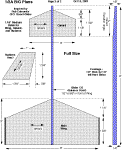 | Use a small"flag" of masking tape on the rod to keep the pod from sliding down too far, or slip a soda straw over the rod to keep the pod raised up enough to allow for the glider to hang off of the pod without touching the blast deflector. The micro-clips could snag the glider at liftoff and rip off a rudder or the wing. So, use another rod as an "umbilical" to hold the ignition clips away from the glider, as in this photo. Pay attention that wind does not make the glider rotate on the rod and accidentally put the wing or rudder in danger of hitting the clips at liftoff. | | For Glide Trim, the Glider should balance in the ballpark of 1/2" to 5/8" in front of the Main wing. Put a mark on the fuselage as a reference point. Add a bit of clay to the nose (at the canard and fuselage joint) or the rear (at the Main wing and fuselage joint) to balance at the mark, then try test glides. Test throw the glider. Assuming good throws: If it dives, add tailweight. If it stalls, add some noseweight. If it turns too much to the right, add a bit of clay to the left rudder/wing joint. If it turns too much to the left, add a bit of clay to the right rudder/wing joint. If you do add clay to a wingtip to fix a turn, you will probably also need to add a bit of clay to the nose to compensate. |


